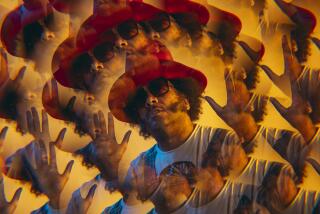Remembrance: ‘Metropolis’ director Fritz Lang
- Share via
Born in Vienna in 1890, director Fritz Lang was a formidable presence in life as on the screen. A journalist once described him as “a noble Roman ruin of a man.”
Barrel-chested, silver-haired, with strong chiseled features, a heavy-lidded penetrating gaze and a deep German-accented voice, Lang was a force to be reckoned with right up to his death in 1976 at his Beverly Hills home. When on rare formal occasions Lang put on a chalk-stripe suit, replaced his glasses with a monocle and picked up his cigarette holder, he recalled the suave, sardonic lady killer who romanced many a star in both Europe and Hollywood.
FOR THE RECORD:
Fritz Lang: An article in the May 14 Calendar section about the late director Fritz Lang said that after his anti-lynching film “Fury” (1936), he made “Nobody Lives Forever.” After “Fury,” he made “You Only Live Once.” Lang was not involved with “Nobody Lives Forever.” —
Working in a bold Expressionist style that revealed a fatalistic pessimism that never left him, Lang anticipated the gangster movie, the James Bond thrillers and the space travel adventure. Director Claude Chabrol once declared, “Without Lang there would be no Hitchcock.”
Lang would be pleased that his “Metropolis” has now received its most complete restoration ever, but there was a time when he might not have cared as much. For years he felt its key assertion, “The mediator between the hand [labor] and head [management] must be the Heart!” was “corny.” In later years, however, he reconsidered his opinion, deciding that the promptings of the heart might be the only thing that could stop mankind from destroying itself.
“Metropolis” was one of several classic silents, including “Dr. Mabuse” and “Die Nibelungen,” that established Lang, along with G.W. Pabst and F.W. Murnau, as the great triumvirate of the Golden Age of the German cinema in the 1920s. Lang made the switch in 1932 to sound with “M,” arguably his masterpiece, which starred an unforgettable Peter Lorre as a tormented child-killer.
By 1936, Lang launched his American career with the terrific anti-lynching film “Fury,” starring Spencer Tracy, following it up with a terse variation on the Bonnie and Clyde legend, “Nobody Lives Forever,” and by the ‘40s made such classic noirs as “Scarlet Street” and “The Woman in the Window,” which carried Joan Bennett to the height of her career. Forever grateful, Bennett and her husband managed to bring a smile to Lang’s face during his final illness with their barrage of loving, funny letters.
It was often said he was a tyrant while directing, and after Lang’s death Roddy MacDowall, who was 12 when he was directed by Lang in “Manhunt,” confided with a smile that Lang could indeed be a “monster on the set” — and yet MacDowall admired and adored the director. Henry Fonda loathed Lang, but he was held in high esteem by the likes of Barbara Stanwyck, Anne Baxter, Thomas Mitchell and Vincent Price.
There’s no denying that Lang had a cruel streak, which was sometimes fueled by jealousy of loving younger couples in his acquaintance. But if Lang was a roué who hated growing old, he also had a deeply paternal side that was consistently loving, sensitive, challenging and encouraging.
After Hitler came to power and Josef Goebbels summoned Lang to tell that him that Der Fuehrer wanted him to head the Third Reich’s film industry, Lang and his lover Lily Latte fled (although apparently not as quickly as he liked to claim) for Paris, where he made the delightful “Liliom” and then was brought to Hollywood by David O. Selznick. Learning English as rapidly as he could, Lang had a rough time adjusting to the monolithic Hollywood studio system at its height, and there were times when he had to humble himself to front offices simply to survive.
Having made “Clash by Night” and “Rancho Notorious” for Howard Hughes at RKO, Lang found himself blacklisted in the early 1950s. Fortunately, Harry Cohn invited him over to lunch to discuss a three-picture deal. “I said to myself, shall I wear my glasses or my monocle” — Lang’s right eye had been damaged during World War I, in which he served in the armed force of the Austro-Hungarian Empire. “And then I asked myself, do I want this job or not?”
He chose glasses, and his next picture, the terse noir “The Big Heat,” in which Lee Marvin threw a pot of hot coffee in Gloria Grahame’s face, would rank among his finest — although it was impossible to persuade him that many of his Hollywood films were the equal of his silent German epics.
Lang settled for the rest of his life in a Spanish cottage with spacious rooms sleekly redesigned by Richard Neutra. It was perched on a precipice on Summit Ridge Drive overlooking Pickfair. Latte, a beautiful and elegant redhead, moved from lover to assistant and then his final companion at Summit Ridge. “I was called the greatest director in Europe,” Lang once said matter-of-factly, “but I was just a hard worker.”
More to Read
Only good movies
Get the Indie Focus newsletter, Mark Olsen's weekly guide to the world of cinema.
You may occasionally receive promotional content from the Los Angeles Times.










